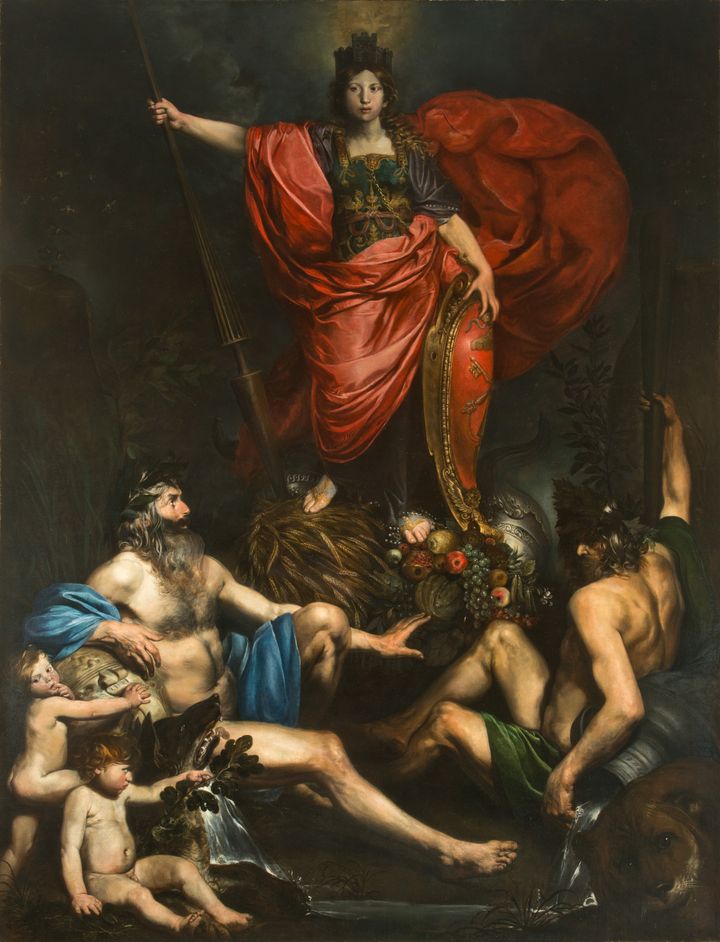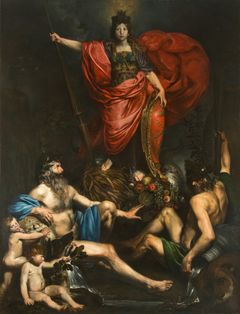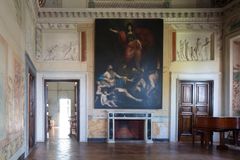Press release and invitation: A masterpiece by Valentin de Boulogne to be exhibited at the Sinebrychoff Art Museum from 6 September

Press conference on Wednesday 6 September at 14:00
The media will be welcome to explore the work, presented by Ira Westergård, chief curator at the Sinebrychoff Art Museum. Also available at the event will be Katariina Mustakallio, who is the chair of the board of the Institutum Romanum Finlandiae foundation, which maintains the Finnish Institute in Rome; the director of the institute, Ria Berg; and professor of art history at the University of Helsinki, Kirsi Saarikangas.
Register for the event at merja.haikio@siff.fi.
Allegory of Italy is a Valentin masterpiece
Allegory of Italy (oil on canvas, 333 x 245 cm) represents the pinnacle of Valentin’s work. It is a representative example from the golden age of Roman Baroque painting. Researchers consider the large-scale painting to be the artist’s main work, along with an altarpiece in the Vatican’s collections. Finnish art collections do not include any similar work from the Italian Baroque period.
In recent years, there has been a growing interest in the painting on show at the Villa Lante, and in Valentin’s work in general. The artist’s first retrospective exhibition, Beyond Caravaggio, was presented at The Metropolitan Museum of Art in New York and the Louvre in Paris in 2016–2017.
In 2023, the painting has been on display at two major exhibitions: the Theodoor Rombouts exhibition at the Museum of Fine Arts Ghent, from 21 January to 23 April,and the exhibition The sovereign image. Urbano VIII and the Barberini familyat Palazzo Barberini, Rome from 18 March to 30 July.
The allegorical painting pays tribute to the Barberini family
The painting was commissioned by Cardinal Francesco Barberini. The workalludes to the achievements of the family and its position at the top of the Rome elite. The family’s position in Rome and Italy culminated in 1623, when Francesco Barberini’s uncle Maffeo Barberini became Pope Urban VIII. In the Barberinis’ new palace, Allegory of Italy was displayed in a place of honour.
An allegory is a metaphor or a metaphorical representation. In the painting, allegorical content is combined with the use of live models and an idiom based on naturalism. The young woman depicted in the work symbolises Italy, the figure in the foreground on the left symbolises the Tiber river in Rome, and the figure in the foreground on the right symbolises the Arno river in Florence. The details of the painting link the work to the Barberini family.
The painting was on display at the Palazzo Barberini until 1812, when it was transferred to the ownership of the Colonna family through marriage. In 1899, by which time the painter of the work had been forgotten, the owner of the Villa Lante, Wolfgang Helbig, bought the work as an “unknown replica from the 19th century”. Helbig’s son, Demetrio Helbig, sold the Villa Lante to the Finnish state in 1950, and four years later, the Finnish Institute in Rome set up operations in the building.
In 1958, the French art historian Jacques Thuillier identified the work as being by Valentin de Boulogne. The work by Valentin is owned by the Institutum Romanum Finlandiae foundation, which maintains the Finnish institute in Rome. After the renovation of the Villa Lante, it will be returned to the main room of the building.
Valentin de Boulogne (1591–1632)
Valentin was from France, and he was born in a village near Paris. Very little is known about his early life or education in France.
He certainly lived in Rome from 1614 onwards, and he felt most at home in the company of Flemish and Dutch artists. He immediately joined the circle of followers of Caravaggio (1571–1610) and adopted a new style based on realism.
Valentin’s art is characterised by strong contrasts of light and shadow. The works consistently tend towards realism, even naturalism. The topics are narrative, and the expressions and gestures of the figures are emphasised.
Some 60 works by the artist are known. As is generally the case with Caravaggio followers, or the Caravaggisti, as they are known, Valentin’s oeuvre also includes many genre paintings depicting tavern scenes, card players, fortune tellers, and musicians. However, most of his work consists of religious paintings, which are held in private collections. Allegory of Italy is completely unique in Valentin’s body of work.
Valentin died prematurely in 1632. As the story goes, he fell into a fountain after a long night of drinking in a tavern, fell ill with a fever, and died a few days later.
Contacts
Merja Häikiö
Viestintä, kuvapyynnöt
Ira WestergårdIntendentti
Lisätietoja näyttelystä Valentin de Boulogne
Kirsi EskelinenMuseonjohtaja
Lisätietoja näyttelyistä
Images
About Sinebrychoffin Taidemuseo
Exhibition curator: Ira Westergård
Public lecture on 13 September at 18:00: Ira Westergård, “Allegory of Italy – a Baroque masterpiece" (in Finnish)
More information on the exhibition:
Museum director Kirsi Eskelinen, tel. +358 294 500 490, kirsi.eskelinen@siff.fi
Chief curator Ira Westergård, tel. +358 294 500 473, ira.westergard@siff.fi
Press material and requests for photography:
merja.haikio@siff.fi, tel. +358 294 500 482
Press images: https://press.sinebrychoffintaidemuseo.fi
Related events: https://sinebrychoffintaidemuseo.fi/en/calendar
Admission
- Free admission to the House Museum and the collection exhibition (Valentin de Boulogne’s painting
- Peder Balkes exhibition from 21 September 2023 onwards: Museum ticket €18 / Concession ticket €12 / Free admission with a Museum Card / Under-18-year-olds €0
Open: Tue, Thu, Fri 11–18, Wed 11–20, Sat, Sun 10–17, Mon closed
Guided tour bookings: Finnish National Gallery sales, tel. +358 294 500 500 (Mon–Fri 10–14), sales@fng.fi
Contact information: Sinebrychoff Art Museum, Bulevardi 40, 00120 Helsinki, tel. +358 294 500 460, www.siff.fi
Facebook @siffmuseo | Instagram @Sinebrychoffartmuseum| Twitter @Sinebrychoffart
The Sinebrychoff Art Museum is part of the Finnish National Gallery, together with the Museum of Contemporary Art Kiasma and the Ateneum Art Museum.
Subscribe to releases from Sinebrychoffin Taidemuseo
Subscribe to all the latest releases from Sinebrychoffin Taidemuseo by registering your e-mail address below. You can unsubscribe at any time.
Latest releases from Sinebrychoffin Taidemuseo
Utställningen Vatten och liv dyker ner i djupen och besöker livliga hamnar13.2.2024 14:00:00 EET | Tiedote
Konstmuseet Sinebrychoffs utställning utforskar människans resa vid vatten från 1600-talet fram till våra dagar. Utställningen lockar oss att reflektera över vårt förhållande till vatten, ett element som är en förutsättning för allt liv.
Veden elämää -näyttely sukeltaa merten syvyyksiin ja vie vilkkaisiin satamiin13.2.2024 14:00:00 EET | Tiedote
Sinebrychoffin taidemuseon näyttelyssä tarkastellaan ihmisten matkaa veden äärellä 1600-luvulta nykypäivään. Näyttely kutsuu pohtimaan suhdettamme veteen, elementtiin, joka on välttämätön elämälle.
Water and Life dives into the depths of the sea and sails to busy ports13.2.2024 14:00:00 EET | Press release
The exhibition at the Sinebrychoff Art Museum explores humans’ journey to water from the seventeenth century until the present day. It invites you to reflect on our relationship with water, one of the essential elements for life.
Inbjudan till förhandsvisning av utställningen Vatten och liv ti 13.2.2024 kl. 141.2.2024 07:54:37 EET | Tiedote
Välkommen till förhandsvisning av utställningen Vatten och liv på Konstmuseet Sinebrychoff tisdagen den 12 februari 2024 kl. 14.00. Utställningens kurator amanuens Salla Heino presenterar utställningen för mediernas representanter. Anmälningar till visningen tas emot på adressen: merja.haikio@siff.fi
KUTSU: Veden elämää -näyttelyn ennakkoesittelyyn 13.2.2024 klo 141.2.2024 07:54:37 EET | Tiedote
Tervetuloa Veden elämää -näyttelyn ennakkoesittelyyn Sinebrychoffin taidemuseoon tiistaina 13.2.2024 klo 14.00. Näyttelyn kuraattori amanuenssi Salla Heino esittelee näyttelyn median edustajille. Ilmoittaudu ennakkoesittelyyn: merja.haikio@siff.fi
In our pressroom you can read all our latest releases, find our press contacts, images, documents and other relevant information about us.
Visit our pressroom


